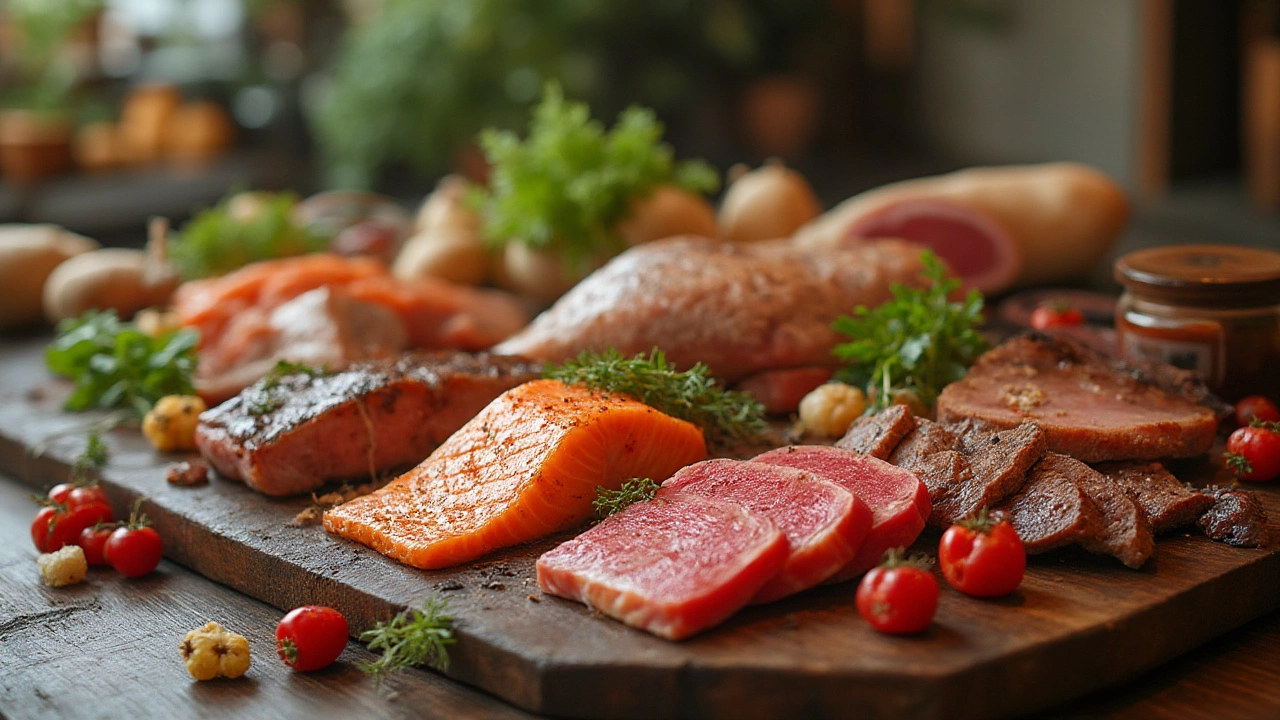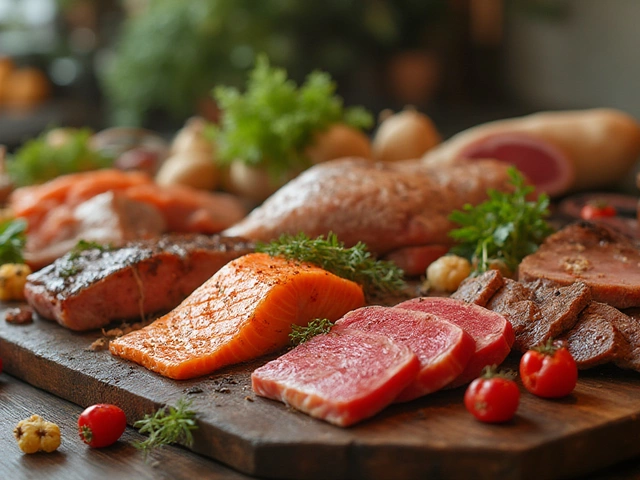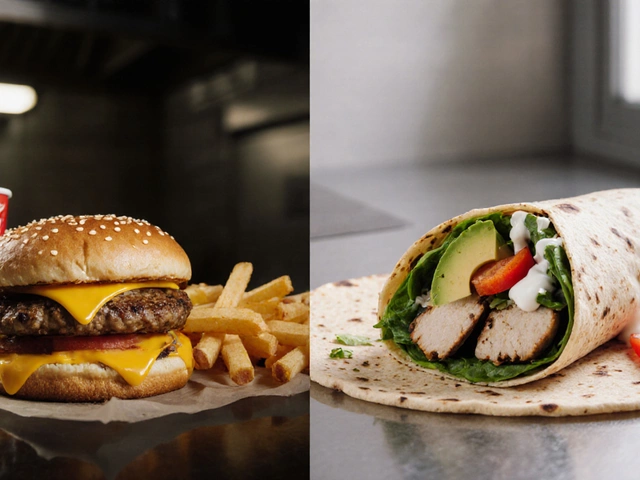Ever stand in the meat aisle, paralyzed by choice? Chicken, beef, fish, turkey, pork... labels shout "organic," "grass-fed," or "lean." But which meat actually wins for your health? Nutrition advice shifts faster than you can grill a steak. Let’s nail down which options deserve a spot on your plate and which ones to leave behind if you want to keep your body running at its best.
How Different Meats Stack Up Nutritionally
If you’re aiming for a healthy diet, not all meats are created equal. Chicken, turkey, fish, beef, pork—even lamb—each brings unique nutrition. So which cut gives you the protein punch, keeps saturated fat at bay, and slips easily into a heart-smart eating plan?
Here’s the truth: healthiest meat isn’t a one-label answer. It’s all about the cut, the species, and even how it’s prepared. But there are some standout stats to know. Let’s look at a clear comparison. Here’s a cheat sheet of the most common “clean” cuts per 100 grams (about 3.5 ounces):
| Meat | Calories | Protein (g) | Total Fat (g) | Saturated Fat (g) | Cholesterol (mg) |
|---|---|---|---|---|---|
| Chicken breast (skinless, roasted) | 165 | 31 | 3.6 | 1.0 | 85 |
| Turkey breast (skinless, roasted) | 135 | 30 | 1.0 | 0.3 | 68 |
| Sirloin steak (lean, broiled) | 206 | 27 | 10 | 4.2 | 78 |
| Pork tenderloin (broiled) | 143 | 26 | 3.5 | 1.0 | 66 |
| Salmon (wild, baked) | 182 | 25 | 8 | 1.6 | 55 |
| Lamb loin (lean, broiled) | 217 | 27 | 11 | 4.6 | 88 |
Blink and you’ll miss it: poultry (especially turkey breast) is lower in calories and fat than red meats. Fish like salmon adds healthy omega-3s, while red meats like beef and lamb, although high in protein, slide in with more saturated fat and calories. Pork tenderloin stays competitive—less fatty than you might guess. Don’t even get me started on processed meats like bacon and sausage. Studies from Harvard hammered the point home: eating processed meat regularly jacks up risk for heart disease and certain cancers, much more so than lean cuts.
Now, there’s more to meat than protein and fat: think micronutrients. Beef shines for iron, B12, and zinc, while pork is a top thiamin source. Salmon can’t be beat for vitamin D and those legendary healthy fats. Chicken and turkey? Solid B vitamins. So “best” isn’t just about macros—micros matter, especially if you have specific health needs like anemia, or you’re watching your cholesterol.

The Pros and Cons of Red Meat, White Meat, and Fish
Ready to challenge what you’ve heard? Red meat gets a bad rap, but is it fair? If you look past the headlines, things get nuanced. Red meat (beef, lamb, pork) can help you hit your iron targets, especially for women and athletes. But the trouble is in the fats: marbled steaks and fatty chops raise LDL cholesterol, the “bad” kind, which can mess with your arteries if eaten too often.
White meat—meaning poultry and some types of fish—tends to have a sleeker nutrition profile. Grilled chicken breast is the diet classic for a reason: high protein, low calories, barely any fat. Turkey does even better, with less fat and cholesterol. Fish, though, is where stuff gets interesting. Fatty fish like salmon, tuna, sardines, and mackerel are packed with EPA and DHA—types of omega-3s proven to slash inflammation, lower heart disease risk, and maybe boost your mood. The American Heart Association isn’t joking around when it recommends fish two times a week for anyone wanting to protect their ticker.
So, what’s the catch? There are a few. Grill marks taste great, but grilling meats at super-high heat (like you do at summer barbecues) produces compounds called HCAs and PAHs, which science links to a slight bump in cancer risk. Processed meats (think deli meats, hot dogs, bacon, sausage) are trouble, point blank—high in sodium, preservatives, and the most tightly linked to cancer and heart disease in big population studies. Even “lean” processed meats don’t get a pass, since it’s mostly the smoking, curing, and additives that turn them from good to trouble.
Don’t forget about sustainability and ethics, either. Beef and lamb are resource-heavy and pack a bigger environmental punch, while chicken, turkey, and especially fish (from sustainable sources) are lighter on the planet. Your healthiest meat might also be the one that lines up with your values.

How to Pick the Healthiest Meats (and Make Them Healthier)
So if you want to eat meat and actually look out for your health, what should you do? Turns out, small choices pay off. Go for lean cuts—skinless chicken breast, pork tenderloin, turkey breast, lean beef sirloin, or round. If you eat red meat, limit big, fatty steaks to once a week or less and skip the processed stuff altogether if you can.
- Trim visible fat before cooking. It’s simple, but cuts way down on saturated fat.
- Keep portions in check. We eat way more meat per meal than we need. Most adults get plenty, so stick to a deck-of-cards size—about 3-4 ounces.
- How you cook matters. Baking, broiling, poaching, or steaming beats frying every time.
- If grilling, don’t char the meat. Flip often, marinate first, and don’t burn it to reduce those nasty HCAs and PAHs.
- Spice it up. Using fresh herbs, garlic, pepper, and lemon adds flavor—so you can skip heavy sauces and extra salt.
Fish deserves a special shout. Wild salmon, sardines, mackerel, rainbow trout—go for “oily” or “fatty” types a couple times a week. Just watch mercury for tuna and swordfish; smaller fish are usually safer. Even shrimp, long feared for cholesterol, is back in the good books according to research—it’s low in fat and calories, high in protein.
If you’re looking for the cleanest source, organic or grass-fed meats (if you can swing it) mean fewer antibiotics and hormones, slightly less saturated fat, and often more healthy fats like omega-3s. But don’t stress if organic’s out of your budget. Lean, unprocessed cuts are still winners.
One last underrated tip: work more plant proteins into your week. Beans, lentils, tofu, nuts, and seeds all boost your nutrition and help slash your meat intake (and grocery bill too). Even swapping just one or two meaty meals for plant-based a week stacks up for your health. If you’re all about that Mediterranean diet (the one doctors can’t stop praising), you’ll notice they lean on fish, poultry, and very little red meat, with plants in between. Not a bad road map to follow.
Bottom line? Meat can absolutely fit into a healthy diet, and picking the healthiest variety is more about quality and quantity than writing off whole categories. Go lean, keep an eye on your portion, favor fish and poultry over red and processed meat, and shake up your routine with the occasional plant-based day. Your body—and the planet—will thank you.








Write a comment